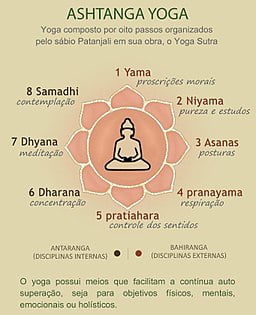“Yamas and Niyamas” are two sets of ethical principles and practices
They are part of the eightfold path of yoga. The yamas are restraints, while the niyamas are observances.
The five yamas are:
- Ahimsa (non-violence): This means avoiding all forms of violence, both physical and verbal.
- Satya (truthfulness): This means speaking the truth, both in words and actions.
- Asteya (non-stealing): This means not taking anything that does not belong to you, either physically or mentally.
- Brahmacharya (celibacy or moderation): This means abstaining from sexual activity, or practicing it with moderation.
- Aparigraha (non-possessiveness): This means not being attached to material possessions or people.
The five niyamas are:
- Sauca (cleanliness): This means maintaining physical and mental cleanliness.
- Santosha (contentment): This means being satisfied with what you have, and not being envious of others.
- Tapas (self-discipline): This means practicing self-discipline in order to overcome your weaknesses.
- Svadhyaya (self-study): This means studying the scriptures and your own inner nature.
- Ishvarapranidhana (surrender to God): This means surrendering your will to a higher power.
The yamas and niyamas are not meant to be rigid rules, but rather guidelines for living a more ethical and spiritual life. They can be adapted to fit your individual needs and circumstances to achieve better self-control.
Here are some ways to practice the yamas and niyamas in your daily life:
- Ahimsa: You can practice ahimsa by being kind to yourself and others, and by avoiding violence in all its forms.
- Satya: You can practice satya by being honest in your words and actions, and by avoiding gossip and slander.
- Asteya: You can practice asteya by not taking things that do not belong to you, and by being mindful of your spending habits.
- Brahmacharya: You can practice brahmacharya by abstaining from sexual activity if you are not ready for it, or by practicing it with moderation.
- Aparigraha: You can practice aparigraha by letting go of material possessions that you do not need, and by being content with what you have.
- Sauca: You can practice sauca by keeping your body and environment clean, and by practicing good hygiene.
- Santosha: You can practice santosha by being grateful for what you have, and by not comparing yourself to others.
- Tapas: You can practice tapas by challenging yourself physically and mentally, and by disciplining your senses.
- Svadhyaya: You can practice svadhyaya by reading the scriptures, studying your own inner nature, and reflecting on your experiences.
- Ishvarapranidhana: You can practice ishvarapranidhana by surrendering your will to a higher power, and by trusting in the divine.
The yamas and niyamas are powerful tools for spiritual growth and transformation. By practicing them, you can learn to live a more ethical and harmonious life.
Image credit
Renato yoga, CC BY-SA 4.0, via Wikimedia Commons
